
A radio telescope is a specialized antenna and radio receiver used to detect radio waves from astronomical radio sources in the sky. Radio telescopes are the main observing instrument used in radio astronomy, which studies the radio frequency portion of the electromagnetic spectrum emitted by astronomical objects, just as optical telescopes are the main observing instrument used in traditional optical astronomy which studies the light wave portion of the spectrum coming from astronomical objects. Unlike optical telescopes, radio telescopes can be used in the daytime as well as at night.
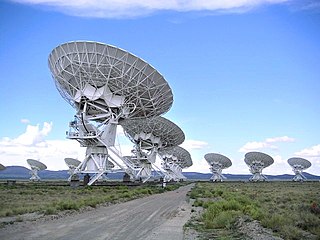
Radio astronomy is a subfield of astronomy that studies celestial objects at radio frequencies. The first detection of radio waves from an astronomical object was in 1933, when Karl Jansky at Bell Telephone Laboratories reported radiation coming from the Milky Way. Subsequent observations have identified a number of different sources of radio emission. These include stars and galaxies, as well as entirely new classes of objects, such as radio galaxies, quasars, pulsars, and masers. The discovery of the cosmic microwave background radiation, regarded as evidence for the Big Bang theory, was made through radio astronomy.
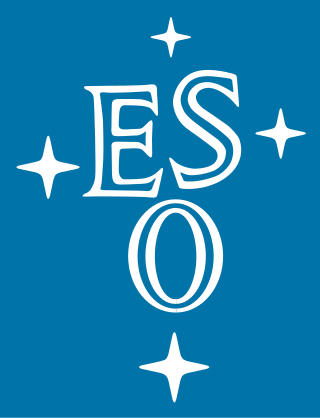
The European Organisation for Astronomical Research in the Southern Hemisphere, commonly referred to as the European Southern Observatory (ESO), is an intergovernmental research organisation made up of 16 member states for ground-based astronomy. Created in 1962, ESO has provided astronomers with state-of-the-art research facilities and access to the southern sky. The organisation employs over 750 staff members and receives annual member state contributions of approximately €162 million. Its observatories are located in northern Chile.

The Karl G. Jansky Very Large Array (VLA) is a centimeter-wavelength radio astronomy observatory in the southwestern United States. It lies in central New Mexico on the Plains of San Agustin, between the towns of Magdalena and Datil, approximately 50 miles (80 km) west of Socorro. The VLA comprises twenty-eight 25-meter radio telescopes deployed in a Y-shaped array and all the equipment, instrumentation, and computing power to function as an interferometer. Each of the massive telescopes is mounted on double parallel railroad tracks, so the radius and density of the array can be transformed to adjust the balance between its angular resolution and its surface brightness sensitivity. Astronomers using the VLA have made key observations of black holes and protoplanetary disks around young stars, discovered magnetic filaments and traced complex gas motions at the Milky Way's center, probed the Universe's cosmological parameters, and provided new knowledge about the physical mechanisms that produce radio emission.

The Atacama Large Millimeter/submillimeter Array (ALMA) is an astronomical interferometer of 66 radio telescopes in the Atacama Desert of northern Chile, which observe electromagnetic radiation at millimeter and submillimeter wavelengths. The array has been constructed on the 5,000 m (16,000 ft) elevation Chajnantor plateau – near the Llano de Chajnantor Observatory and the Atacama Pathfinder Experiment. This location was chosen for its high elevation and low humidity, factors which are crucial to reduce noise and decrease signal attenuation due to Earth's atmosphere. ALMA provides insight on star birth during the early Stelliferous era and detailed imaging of local star and planet formation.

The James Clerk Maxwell Telescope (JCMT) is a submillimetre-wavelength radio telescope at Mauna Kea Observatory in Hawaii, US. The telescope is near the summit of Mauna Kea at 13,425 feet (4,092 m). Its primary mirror is 15 metres across: it is the largest single-dish telescope that operates in submillimetre wavelengths of the electromagnetic spectrum. Scientists use it to study the Solar System, interstellar dust and gas, and distant galaxies.

The Low-Frequency Array (LOFAR) is a large radio telescope, with an antenna network located mainly in the Netherlands, and spreading across 7 other European countries as of 2019. Originally designed and built by ASTRON, the Netherlands Institute for Radio Astronomy, it was first opened by Queen Beatrix of The Netherlands in 2010, and has since been operated on behalf of the International LOFAR Telescope (ILT) partnership by ASTRON.

Owens Valley Radio Observatory (OVRO) is a radio astronomy observatory located near Big Pine, California (US) in Owens Valley. It lies east of the Sierra Nevada, approximately 350 kilometers (220 mi) north of Los Angeles and 20 kilometers (12 mi) southeast of Bishop. It was established in 1956, and is owned and operated by the California Institute of Technology (Caltech). The Owens Valley Solar Array portion of the observatory has been operated by New Jersey Institute of Technology (NJIT) since 1997.
The Combined Array for Research in Millimeter-wave Astronomy (CARMA) was an astronomical instrument comprising 23 radio telescopes, dedicated in 2006. These telescopes formed an astronomical interferometer where all the signals are combined in a purpose-built computer to produce high-resolution astronomical images. The telescopes ceased operation in April 2015 and were relocated to the Owens Valley Radio Observatory for storage.

The Atacama Pathfinder Experiment (APEX) is a radio telescope 5,064 meters above sea level, at the Llano de Chajnantor Observatory in the Atacama desert in northern Chile, 50 km east of San Pedro de Atacama built and operated by three European research institutes. The main dish has a diameter of 12 m and consists of 264 aluminium panels with an average surface accuracy of 17 micrometres (rms). The telescope was officially inaugurated on September 25, 2005.

Associated Universities, Inc. (AUI) is a research management corporation that builds and operates facilities for the research community. It is a not-for-profit 501(c)(3) corporation headquartered in Washington, D.C., United States. The current president is Adam Cohen. The corporation's major current operating unit is the National Radio Astronomy Observatory, which it operates under a Cooperative Agreement with the National Science Foundation.

The Plateau de Bure Interferometer (PdBI) was a six-antenna interferometer on the Pic de Bure (2550 m) in the French Alps, operated by the Institut de radioastronomie millimétrique. In 2014, it has been replaced by the Northern Extended Millimeter Array. It was specifically designed for millimetre-wave observations and specialises in studies of line emission from molecular gas and radio continuum of cold dust.
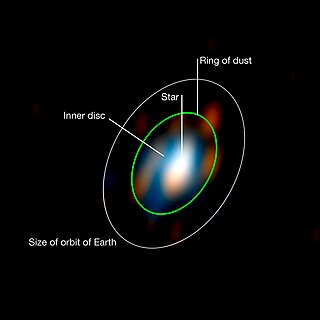
An astronomical interferometer or telescope array is a set of separate telescopes, mirror segments, or radio telescope antennas that work together as a single telescope to provide higher resolution images of astronomical objects such as stars, nebulas and galaxies by means of interferometry. The advantage of this technique is that it can theoretically produce images with the angular resolution of a huge telescope with an aperture equal to the separation, called baseline, between the component telescopes. The main drawback is that it does not collect as much light as the complete instrument's mirror. Thus it is mainly useful for fine resolution of more luminous astronomical objects, such as close binary stars. Another drawback is that the maximum angular size of a detectable emission source is limited by the minimum gap between detectors in the collector array.

The IRAM 30m telescope is a radio telescope, located in the Sierra Nevada Mountain Range, Spain. It is operated by the Institute for Radio Astronomy in the Millimetre Range (IRAM) for observing astronomical objects in the millimetre range of the electromagnetic spectrum. With its large surface and wide-angle camera, the telescope is capable of exploring vast cosmic objects. It is one of the largest and most sensitive millimetre wavelength telescopes in the world, serving over 200 astronomers annually. The telescope is primarily used to study interstellar clouds, star nurseries, galaxies, and black hole jets.

The Large Latin American Millimeter Array (LLAMA) is a single-dish 12 m Nasmyth optics antenna which is under construction in the Puna de Atacama desert in the Province of Salta, Argentina, next to the Qubic experiment. The primary mirror accuracy will allow observation from 40 GHz up to 900 GHz. After installation it will be able to join other similar instruments to perform Very Large Base Line Interferometry or to work in standalone mode. Financial support is provided by the Argentinian and Brazilian governments. The total cost of construction, around US$20 million, and operation as well as the telescope time use will be shared equally by the two countries. Construction planning started in July 2014 after the formal signature of an agreement between the main institutions involved.
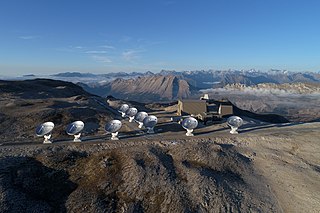
The Northern Extended Millimeter Array (NOEMA) is one of the largest astronomical facilities on European ground and the most powerful radio telescope in the Northern Hemisphere operating at millimeter wavelengths. It consists of a large array of twelve 15-meter antennas that can spread over distances of up to 1.7 kilometers, working together as a single telescope.
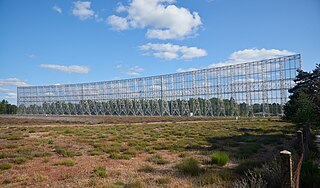
The Nançay Radio Observatory, opened in 1956, is part of Paris Observatory, and also associated with the University of Orléans. It is located in the department of Cher in the Sologne region of France. The station consists of several instruments. Most iconic of these is the large decimetric radio telescope, which is one of the largest radio telescopes in the world. Long established are also the radio heliograph, a T-shaped array, and the decametric array operating at wavelengths between 3 m and 30 m.

Violette Impellizzeri is an Italian astronomer, astrophysicist, and professor.

Johann Anton Zensus is a German radio astronomer. He is director at the Max Planck Institute for Radio Astronomy (MPIfR) and honorary professor at the University of Cologne. He is chairman of the collaboration board of the Event Horizon Telescope (EHT). The collaboration announced the first image of a black hole in April 2019.






















